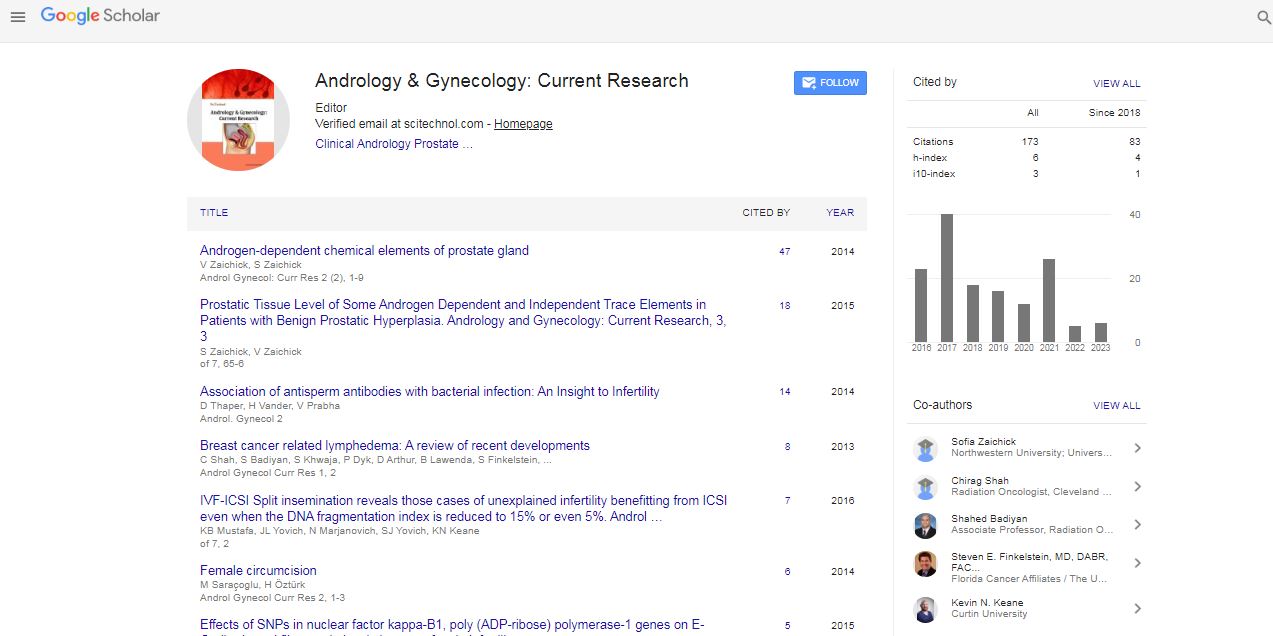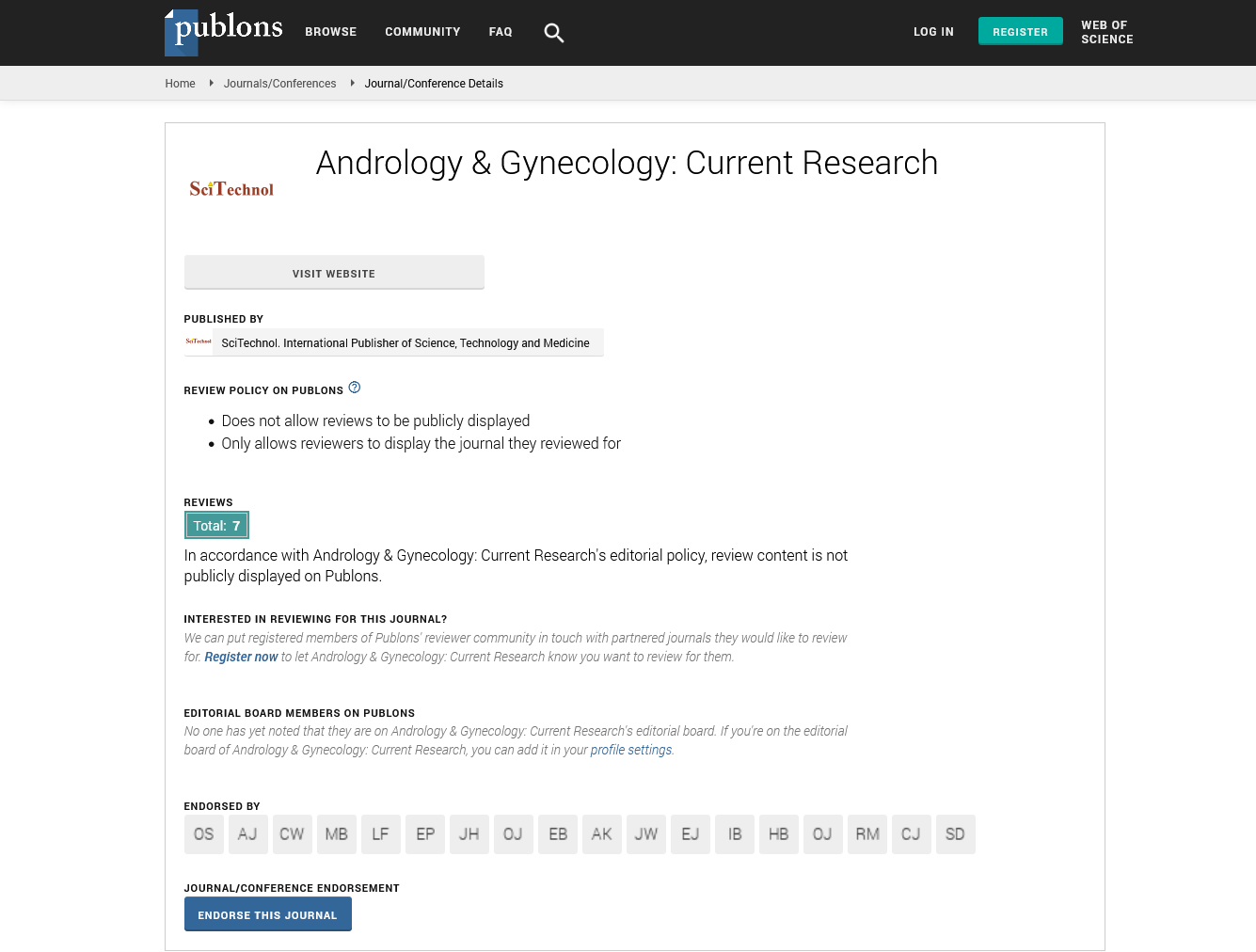Editorial, Androl Gynecol Curr Res Vol: 2 Issue: 4
Laparoscopic Power Morcellation and Gynecologic Surgery: Lets Not Jump to Conclusions
| Steven R. Lindheim* and Jerome L. Yaklic |
| Boonshoft School of Medicine, Wright State University, Dayton, OH |
| Corresponding author : Steven R. Lindheim Boonshoft School of Medicine, Wright State University, Dayton, OH, 128 Apple Street, Suite 3800 Weber CHE Dayton, OH, USA 45409 Tel: 937-208-2301; Fax: 937-222-7255; E-mail: steven.lindheim@wright.edu |
| Received: May 27, 2014 Accepted: June 01, 2014 Published: June 05, 2014 |
| Citation: Lindheim SR, Yaklic JL (2014) Laparoscopic Power Morcellation and Gynecologic Surgery: Let’s Not Jump to Conclusions. Androl Gynecol: Curr Res 2:3. doi:10.4172/2327-4360.1000e107 |
Abstract
Laparoscopic Power Morcellation and Gynecologic Surgery: Let’s Not Jump to Conclusions
It is impossible to conduct any surgical procedure without risk. We need to be solution driven and evidence based to not draw to poor conclusions. A frequent quote from Samuel Butler: “There is a big difference between what we know and what we think we know, we need to learn more before we jump to conclusions”. Let’s not be reactive, but proactive! We need to acknowledge the FDA warning regarding the use of LPM during LH and LM; however, let’s also advocate for a national tumor registry. This would go a long way to identify clinical factors that may reliably detect US and LMS where currently there are none.
Keywords: tumor
Editorial |
|
| On April 17, the U.S Food and Drug Administration (FDA) issued a safety communication to health care providers warning against the use of laparoscopic power morcellation (LPW) during laparoscopic hysterectomy (LH) and myomectomy (LM). Estimates suggest that about 1 out of every 352 undergoing LH or LM for presumed benign fibroids may have an unsuspected uterine sarcoma (US) and 1 out of every 498 may have a leiomyosarcoma (LMS) [1]. Given the lack of reliable methods to detect US or LMS pre-operatively, the FDA discouraged the use of LPM during minimally invasive surgery to minimize the risk of metastatic spread, chances for long-term survival and overall quality of life. The FDA warnings followed media attention about a physician who underwent a LM with LPM which apparently caused metastatic spread of her undiagnosed US [2]. She became a vocal critic of LPM during MIS and generated enormous public support. This event followed reports which demonstrated an increased risk of recurrence and shorter progression-free survival when LPM was used in cases with unsuspected LMS compared with en bloc resection [3-9]. As a result, women with metastatic cancer following MIS with LPM may be entitled to compensation from manufacturers because devices were not sufficiently studied and warnings about the cancer risks to patients and providers were inadequate. A growing number of hospitals are announcing that they will no longer perform LPM cases and manufacturers are halting sales and distribution of devices until the FDA and medical communities can determine the correct course of action. Despite recent warnings, the American College of Obstetricians and Gynecologists (ACOG) and the American Association of Gynecologic Laparoscopists (AAGL) have both issued statements defending MIS using LPM stating it is generally safe, the overall risk of metastatic cancer spread is rare and the risk must be weighed against the benefits provided by MIS [10,11]. Patient safety and avoiding preventable harm must be of paramount importance. Concerns related to LMP include the rare morcellator-related visceral and vascular injuries (a recent systematic review and the FDA device database discuss 55 occurring during both gynecologic and nongynecologic procedures) [12]. There is concern about the tissue that can be disseminated during LPM. Fragments of tissue that are not retrieved may result in pain, infection and serious morbidity [13,14] intracorporeal morcellation has been reported to result in seeding of both benign [15-18] and malignant tissues [3-9]. AAGL practice guidelines however report no increase in the risk of subsequent diagnosis of endometriosis [19,20] and, based on 2 retrospective studies, estimated the incidences for parasitic leiomyomata between 0.1% and 1% [17,18]. The more obvious and significant concern remains the risk of LPM of an unidentified malignancy with possible resultant upstaging of disease and worsened prognosis [6,7,21]. LMS are notoriously aggressive tumors associated with poor prognosis, even in the absence of tissue morcellation; however, LMS is relatively rare with an estimated incidence of 1 in 10,000 women in the general population and 1 in 1,000 women undergoing surgery for presumed leiomyomata [6,22-24]. | |
| So do we jump to the conclusion that abandoning MIS and LPW is the right thing to do? A Biblical example of making wise decisions can be seen from King Solomon. When he became king as a lad, he apparently felt inadequate for the job, but his desire was to discern between right and wrong, between good and evil, and be fair in his judgments. He prayed to God for help. God was pleased that Solomon didn't want to hastily make false assumptions (I Kings 3), and Solomon went on to become widely known and respected for his great wisdom and God-inspired understanding. So in making a wise decision, we must reflect on the facts. Since the introduction of the first uterine hand-held morcellator in 1991 [25] and the electronic LPM in 1993 [26], nearly half of the 400,000 inpatient-based hysterectomies performed every year in the United States for benign indications include the use of LPM [27]. Without LPM, many would be ineligible for MIS and deny the clear benefits of this approach. MIS and the use of LPM substantially reduces morbidity including blood transfusion, surgical site infection, venous thrombosis, and postoperative pain, while at the same time improving quality of life, time to return to baseline function and length of stay. | |
| It is impossible to conduct any surgical procedure without risk. We need to be solution driven and evidence based to not draw to poor conclusions. A frequent quote from Samuel Butler: “There is a big difference between what we know and what we think we know, we need to learn more before we jump to conclusions”. Let’s not be reactive, but proactive! We need to acknowledge the FDA warning regarding the use of LPM during LH and LM; however, let’s also advocate for a national tumor registry. This would go a long way to identify clinical factors that may reliably detect US and LMS where currently there are none [24,28]. We need more research on potential screening techniques including: magnetic resonance imaging (MRI), particularly diffusion-weighted, and measurement of total LDH and LDH isoenzyme type 3 on a larger scale [26,27]. Lastly, while alternative treatments like removal of tissue through a minilaparotomy, colpotomy, and vaginal hysterectomy should be considered, we need to identify ways to make LPM safer including the use endobags. Should we let MIS and LPM become a dying art just when they are getting started? If we prematurely jump to conclusions, we may be jumping to the wrong conclusion. Let’s not jump! | |
References |
|
|
 Spanish
Spanish  Chinese
Chinese  Russian
Russian  German
German  French
French  Japanese
Japanese  Portuguese
Portuguese  Hindi
Hindi 


